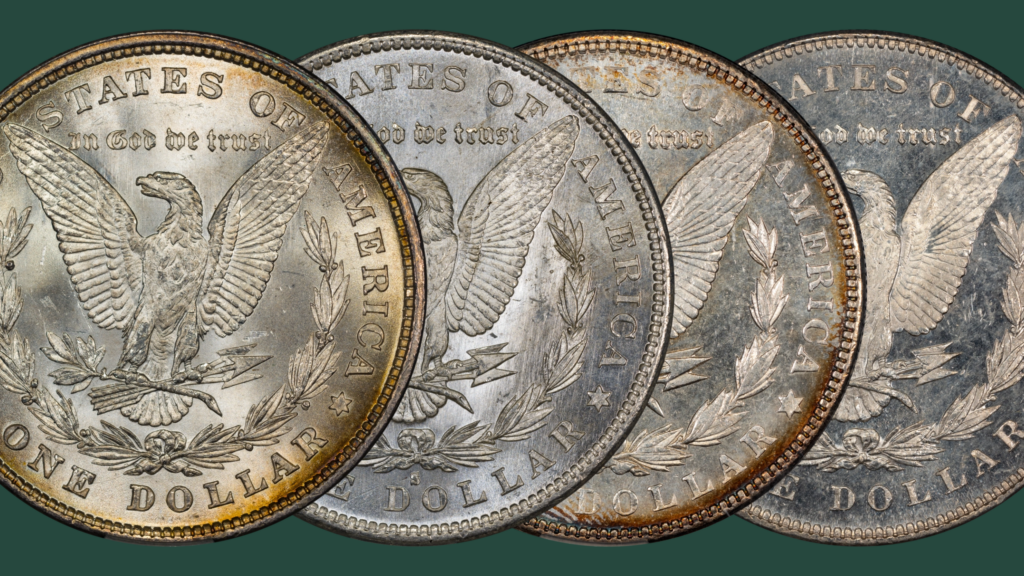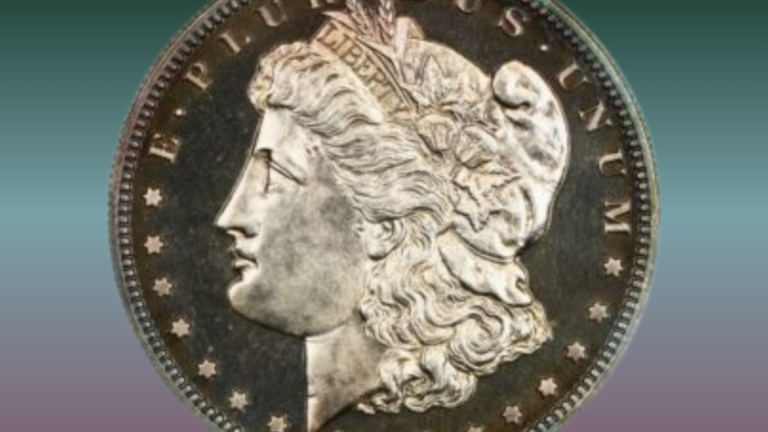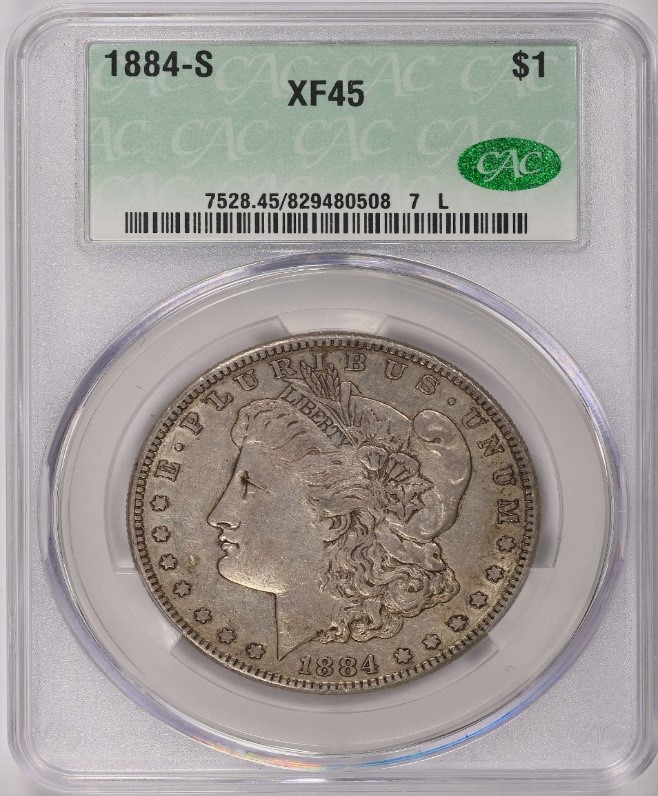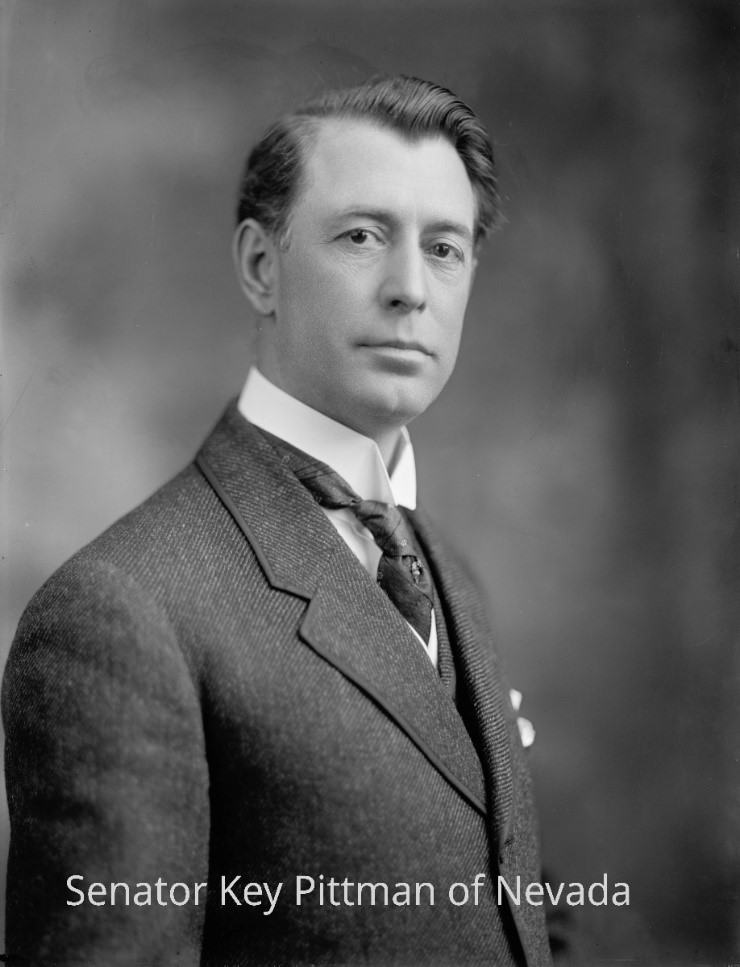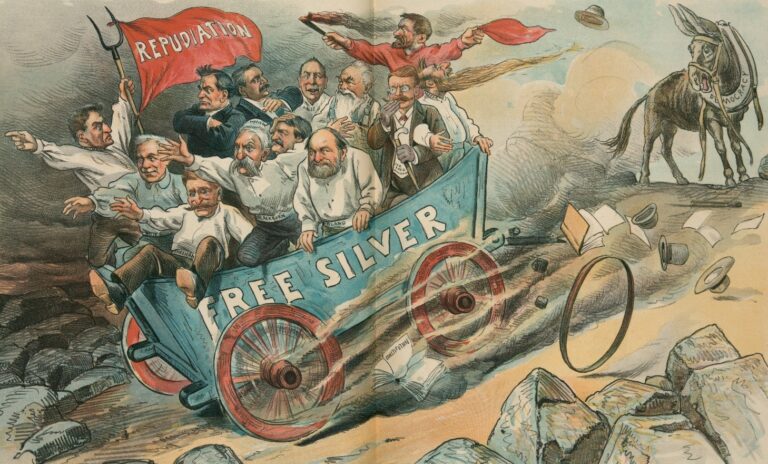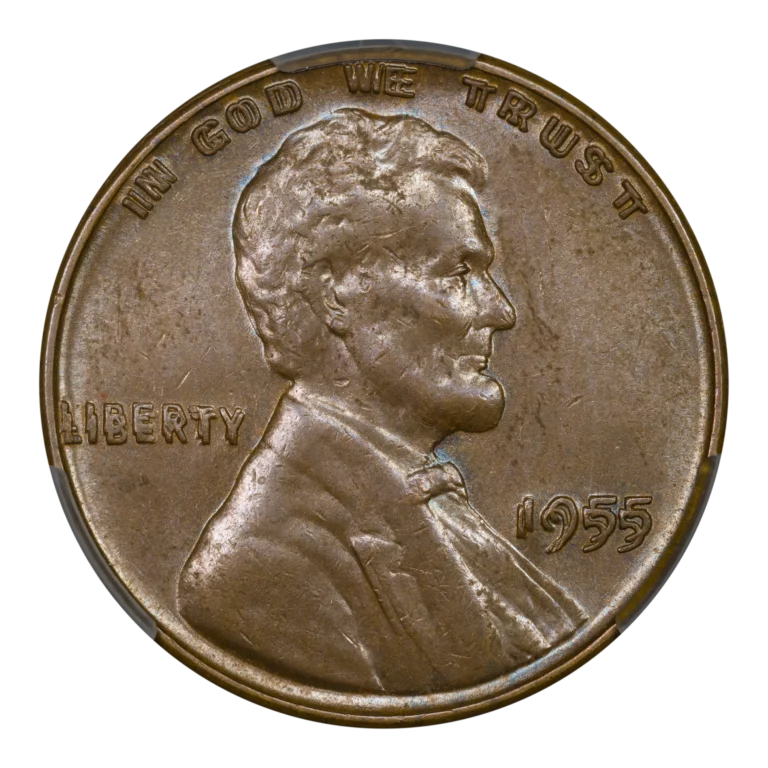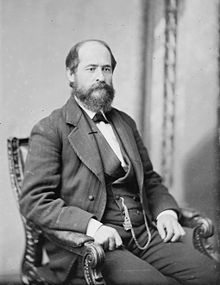by Greg Reynolds
Ever since the late 1970s, Morgan silver dollars have been extremely popular with collectors. Beginners, though, are sometimes bewildered, confused, annoyed, or just puzzled by listings of many varieties and anomalies of Morgan dollars, most of which are very difficult to discern. The purpose here is to explain that the overdates, strange anomalies and overmintmarks that are listed in standard price guides and other references are not required for a set ‘by date’ (and mint location). It is fair and logical to ignore them.
Regarding varieties that are often listed in standard, widely read references, many collectors assume without evidence or critical thinking that each is needed for a complete set ‘by date (and mint location). The reality is that these varieties are very hard to identify and are subtle in nature, items for specialists rather than for typical collectors of Morgan dollars to pursue.
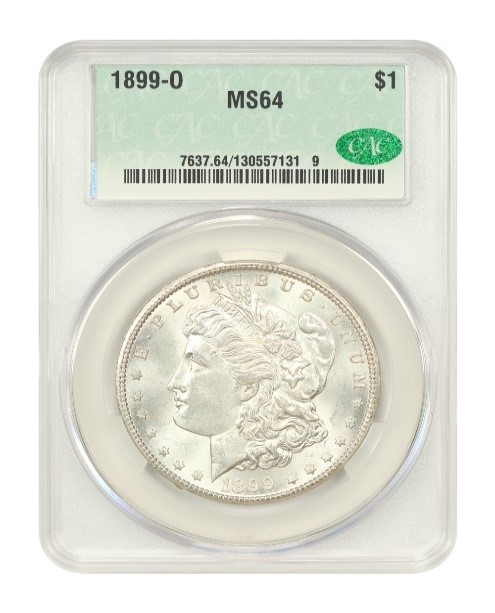
Most, though certainly not all, U.S. coin collectors like to assemble sets, and the rules or requirements for a set of Morgan dollars are very unclear to beginners and to many intermediate-level collectors. Moreover, if there were no rules, there would be no way to make a determination as to whether a set is complete or not. There is thus a need for careful and critical discussions of the rules for the completion of a set of coins of each design type, especially for popular series like Morgan dollars.

Join the CAC Grading Club Today!
Interested in having your coins graded? With CAC, we make it easy! Just sign up for the Grading Club, and you’ll receive $50 in grading credits, a free subscription to the CAC quarterly Rare Coin Market Review magazine, and direct submission privileges to CAC Grading. This means you can submit to the premiere grading service from the convenience of your own home!
The Minting & Circulation of Morgan Dollars
Why do so many collectors, especially beginners, focus on Morgan dollars anyway? One reason is that they are relatively plentiful, the most common of all classic U.S. silver coins (1794-1934). Another reason is that literally millions of pre-1921 Morgan dollars were released by the U.S. Treasury Department during the second half of the twentieth century, and some such releases were accompanied by a great deal of publicity. Still another reason is that Morgans have been heavily promoted by marketing firms. Perhaps the leading reason, however, is that Morgan silver dollars are part of the culture of the nation and are symbolic of bygone eras, dynamic and fascinating periods of U.S. history. Please see my articles on the CAC website about the history of silver dollars.
Morgans were struck at five mints: Philadelphia, New Orleans (mintmark ‘O’), San Francisco (‘S’), Carson City (Nevada) and, just in 1921, Denver. Philadelphia Mint Morgan dollars do not have mintmarks. For the others, the mintmark is found below the eagle on the reverse (back of the coin) and is one letter except ‘CC’ for Carson City.
The official replicas of Morgan dollars that were minted by the U.S. Treasury Department in recent years are a different matter, though these could easily be added to sets of true coins. In my view, sets of classic U.S. coins should be kept distinct from modern coins, contemporary issues, and official replicas.
Business Strikes and Proofs
I am referring here to business strikes, coins that were minted with routine or ordinary methods. It is wrong to refer to business strikes as circulation strikes, especially in regard to Morgan dollars. As I explain in my articles about the history of Morgans, the political forces that pushed for mass production of Morgan dollars really did not wish for nor intend for most Morgan dollars to circulate; they structured legislation such that most Morgans would sit in government vaults. Millions of Morgan dollars served as government-reserves for silver certificates, a form of U.S. paper money.
Special Morgan dollars, with mirror surfaces, called Proofs were made for collectors, politicians and really anyone who ordered them by mail from the Philadelphia Mint. Usually, a set of Proof Morgan dollars is considered to be something different from a set of business strikes.
Someone building a set of business strikes should be aware of the reality that a business strike 1895 has never been discovered, yet more than 600 Proof 1895 silver dollars survive. While Philadelphia Mint records indicate that 12,000 1895 business strikes were produced, these may have all been melted without ever leaving the possession of the government, as hundreds of millions of Morgan dollars were melted by the U.S. Treasury Department during the twentieth century.
Another realistic possibility is that this mint record is wrong, perhaps a bookkeeping error. Maybe those 12,000 “1895” business strikes were really dated 1894?
Someone collecting business strike Morgans by date (and mint location) should just ignore the 1895 Philadelphia Mint issue, since there is no firm evidence that 1895 business strikes ever existed. An 1895-O and an 1895-S, however, are required for a set.
By tradition and via logic, Morgan dollars are collected ‘by date’ (and U.S. Mint location). When I was a kid, the term ‘date’ in the context of coins referred to a combination of a ‘year’ and mint location. An 1893-S is a key date Morgan while an 1893-O is not a key date. These are two different dates of the same year.
After a collector finishes a set of business strikes, he or she can think about purchasing an 1895, which is very expensive. While a decision as to whether to include an 1895 is rather straightforward, it is logical to ignore complex varieties.
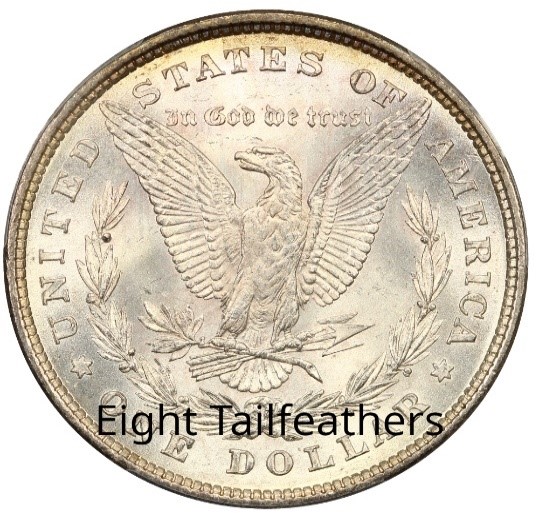
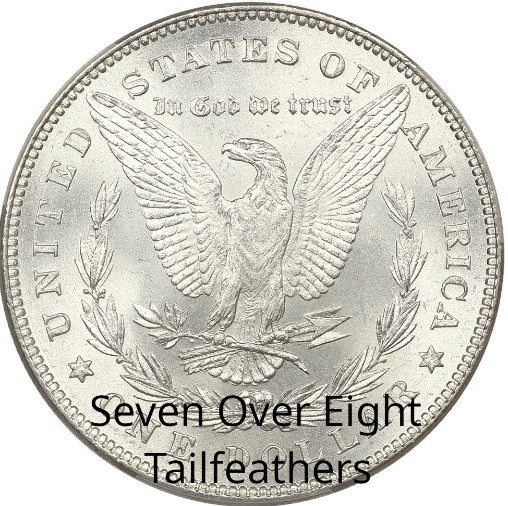
Tailfeathers among Morgan Dollars
Among 1878 Morgan dollars, there are some for which the eagle has eight tailfeathers while most of the others feature just seven tailfeathers. To make matters more complicated, there are varieties struck from dies where seven tailfeathers were impressed over eight tailfeathers. The tailfeathers are very small and have little relevance to the overall design and aesthetic appearance of the coin. Indeed, only experienced coin collectors would notice the discrepancies in tailfeathers, anyway.
In my opinion, the difference between seven and eight tailfeathers is not important and is not particularly significant. With seven or with eight tailfeathers, the design of the eagle is the same and the overall artistic concepts are the same. In my view, one 1878 Philadelphia Mint issue Morgan dollar is sufficient for a set ‘by date,’ though admittedly my view is in the minority.
There are experts who have said or would suggest that four Philadelphia Mint 1878 Morgans are needed for a set ‘by date’: 1878 – 8 tailfeathers, 1878 – 7 over 8 tailfeathers, 1878 – 7 tailfeathers with the “reverse of 1878,” and 1878 – 7 tailfeathers with the “reverse of 1879”! While the difference between seven and eight tailfeathers is noticeable to someone who likes to examine minor design details, the distinctions between the ‘reverse of 1878’ and the ‘reverse of 1879’ require laser-like concentration to discern and are unimportant to most collectors.
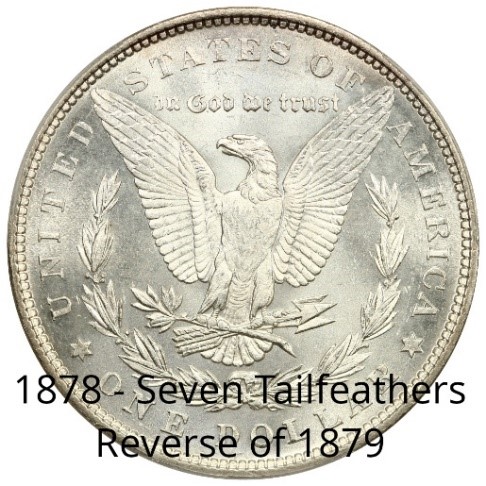
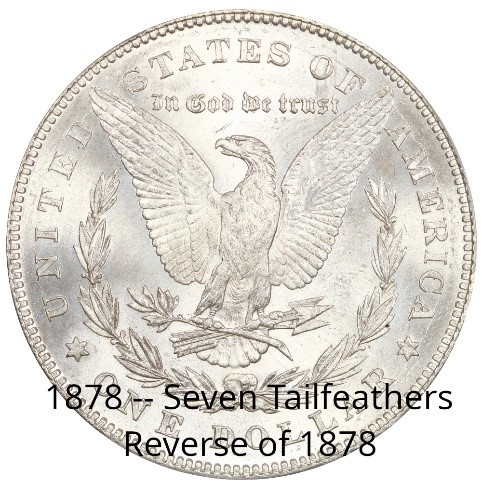
There are corresponding ‘reverse of 1878’ and ‘reverse of 1879’ varieties for other ‘year and mint’ combinations, including 1879-S. Two different hubs were used to make reverse silver dollar dies in 1878. One of the two was slightly sharper in some areas and had a few minutely different details, which only a small percentage of Morgan dollar collectors would ever notice. Yes, these are of interest for collectors who enjoy studying die varieties and spend many years collecting varieties of Morgan dollars. Beginners and most intermediate-level collectors should just ignore the distinctions between the ‘reverse of 1878’ and the ‘reverse of 1879.’
Several standard references list multiple varieties of 1878, 1879-S, 1880, 1880-O, 1880-S and 1880-CC Morgan dollars, with the implication that at least two of each are needed for a complete set of Morgan dollars ‘by date’ (and mint location). I maintain that just one of each is needed. The varieties of these are subtle and hardly noticeable.
Morgan Dollar Varieties and Set Types
After a collector completes a set ‘by date’ (and mint location), he or she can then think about adding varieties. A more logical alternative, in my opinion, would be to begin a set of a different design type ‘by date.’ After completing a set of Morgans, it would be unsurprising for a collector to focus on a set of Peace dollars, Walking Liberty half dollars, Barber quarters, Mercury dimes, Liberty Head nickels, post-1876 Liberty Head $20 gold coins, or ‘With Motto’ Liberty Head $10 gold coins.
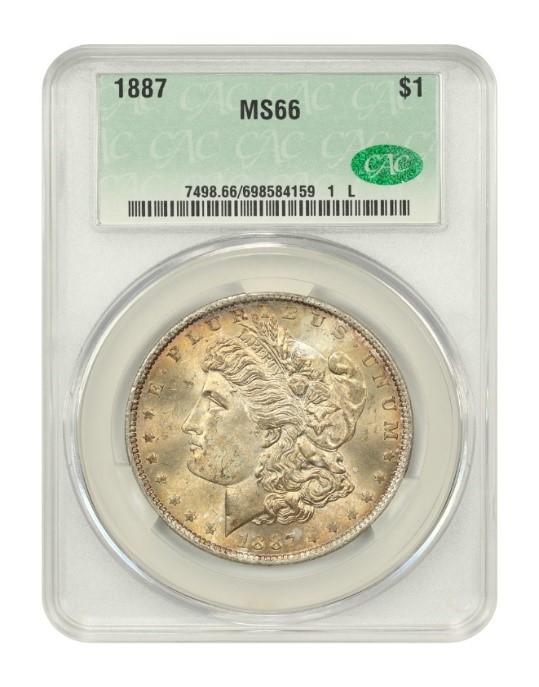
While there are some collectors who enjoy spending decades collecting coins of one design type, I suggest to relatively new collectors that they think about assembling sets ‘by date’ of more than one design type. Of course, there is no single collecting formula that pleases everyone. The points here are not directed to people who have already decided to collect by die variety. After decades of conversations with collectors, however, I conclude that most collectors enjoy owning coins of different design types and denominations. In many cases, a collector will not know how much he or she enjoys a new project until such a project is underway.
It becomes difficult to finish one set and begin another if a large amount of time is spent on minor varieties. For example, it is often implied by standard references that two 1879-CC Morgans are needed for a set, one with a regular ‘CC’ mintmark and another 1879-CC with a so-called “Capped” CC mintmark. There are rough bits of metal and graininess on and about the so-called “Capped” CC mintmark on most such coins. Tenable theories notwithstanding, the nature of the anomalies regarding the CC mintmark on these is very unclear and these anomalies are annoying.
The “Capped” CC mintmark variety seems like a product of a sloppily prepared and/or accidentally damaged reverse die, rather than something separate and appealing. The fact that the 1879-CC “Capped” mintmark variety does not command a premium is unsurprising, even though it is notably scarcer. The lack of a premium is consistent with my view regarding its lack of importance.

Besides, on many nineteenth century U.S. coins, there are mintmark variations. The boldness, size, shape, relief, and format of the mintmark may vary among coins of the same design type that were struck at the same mint during the same year.
I suggest buying just one 1879-CC silver dollar for a set. This is a relatively expensive date anyway. It would be illogical for a budget-minded collector to seek two 1879-CC Morgans for a regular set.
Morgan Dollar Overdates
The 1880/79-O Morgan dollar overdate, if it is an overdate, is just too minor to be required for a set ‘by date.’ Moreover, there is minimal, if any, evidence of an overdate on most coins of this die variety. The various 1880-CC varieties are even more subtle and obscure. These are interesting to collectors who focus on die varieties and enjoy using microscopes. The supposed faint traces of a seven about the corresponding numeral eight on many 1880-CC Morgans are not relevant to completing a set ‘by date’ (and mint location). These are relatively inconsequential minting anomalies, which fascinate specialists in die varieties. It is logical and time-efficient for most collectors of Morgans to ignore them, though I am intrigued by the research by specialists in minting anomalies.
On high grade “1880/79-S” Morgans, I find very little evidence, under five- or ten-times magnification of a ‘7’ or a ‘9’! I admit that I have not scrutinized a large number of these, and I have not viewed an 1880-S Morgan with a microscope.
While I accept that specialists in varieties of Morgan dollars have concluded that the 1887/6 and the 1887/6-O are true overdates, scientific knowledge of the subject matter and a microscope would be required to demonstrate that any one coin is an overdate. The evidence is scant and barely perceptible.
The scientific cases supporting the often-listed overdates in the series of Morgan dollars could be far more powerful than I have imagined. The distinction between an overdate that is needed for a complete set ‘by date’ and an overdate that is just of interest to collectors of die varieties relates to magnification and boldness. In conversations with John Albanese over the years, he and I agreed that an overdate that can be readily seen and identified without magnification is usually an additional date of the same year (and mint location). In my view, there are no such overdates in the series of Morgan dollars.
The 1807/6 large cent, 1918/7-D Buffalo nickel, 1806/5 quarter and 1918/7-S quarter are examples of overdates that constitute distinct dates of their respective series. Those overdates are very easy to see.
Morgan Dollar Overmintmarks
Overmintmarks are different from overdates. During the nineteenth century, an overmintmark came about in cases where the mintmark on a die was overpunched with a different mintmark. Of course, the mintmarks relate to mints other than the headquarters mint in Philadelphia, as coins struck at the Philadelphia Mint were not supposed to have mintmarks before the twentieth century.
It is not practical to explain all the theoretically possible situations where a mintmark was mistakenly punched and had to be ‘corrected’ by the overpunching of a different mintmark. In the nineteenth century, mintmarks were added to dies via hand-punching’s rather than included in hubs.
The most likely explanation for an overmintmark was the re-purposing of a reverse die. If a mintmarked die that was used or was planned for use at one U.S. Branch Mint was later earmarked for use at another Branch Mint, an existing mintmark was replaced with another, usually though overpunching. Such cases were rare.
The so-called “1882-O/S” is barely perceptible. A microscope would be needed to be certain that any such coin really is an overmintmark variety. There is raised metal inside the ‘O,’ though concentration and analysis would be required to figure that the visible matter was part of an earlier punched ‘S.’ Although interesting, the so-called “1882-O/S” just should not be listed as if it is a major variety. It is a minor anomaly, not a major variety.
Although it is very believable that the 1900-O/CC is definitely a true overmintmark, the CC is faint and not well defined, even on choice to gem quality coins. On Very Fine grade coins, concentration, time, and knowledge are needed to discern traces of something besides an ‘O’ in the vicinity. Certainly, this overmintmark is not apparent enough for the 1900-O/CC variety to qualify for the status of a date in addition to a ‘normal’ 1900-O in a set. Just one 1900-O Morgan is sufficient for a quest to complete a set ‘by date’ (and mint location).
Though neither an overdate nor an overmintmark, the 1890-CC ‘Tailbar Reverse’ variety is very much apparent without magnification and does capture the attention of anyone who has carefully examined many Morgan dollars. Though not really a requirement for a set ‘by date,’ as the “Tailbar” is unrelated to the numerals, mintmark or design type, a coin of the ‘Tailbar Reverse’ variety might be an entertaining supplement to a set ‘by date.’

Collector Advice for Morgan Dollars
The 1901 ‘Doubled Die Reverse’ is barely noticeable in cases where it is discernible without high magnification. Slight doubling on some reverse design elements appears as if these are outlined. I recommend against including this variety, which is expensive, in a set, unless a science-minded collector is seeking dozens of subtle varieties. It is not needed for a regular set.
It is important to emphasize the logical requirements of a set ‘by date,’ as the vast majority of collectors or potential collectors who would even consider assembling a set of a classic series of U.S. coins are not scientists and wish to enjoy collecting coins without spending a tremendous amount of time on any one project. Price guides and other standard references should not list minor varieties as if they are needed for sets.
Indeed, while I have a great deal of respect for the science-minded collectors who spend hundreds of hours studying die varieties, I feel compelled to offer advice to the vast majority who would like coin collecting to be fun, straightforward, and a hobby that does not take a great deal of time. Also, I am hoping to draw additional people into the hobby by pointing out that completing meaningful sets, which are important in the culture of coin collecting, need not be complicated or especially time-consuming.
Images, before modification, are courtesy of DLRC of Virginia Beach (www.davidlawrence.com).
Copyright © 2023 Greg Reynolds
About the Author
Greg is a professional numismatist and researcher, having written more than 775 articles published in ten different publications relating to coins, patterns, and medals. He has won awards for analyses, interpretation of rarity, historical research, and critiques. In 2002 and again in 2023, Reynolds was the sole winner of the Numismatic Literary Guild (NLG) award for “Best All-Around Portfolio”.
Greg has carefully examined thousands of truly rare and conditionally rare classic U.S. coins, including a majority of the most famous rarities. He is also an expert in British coins. He is available for private consultations.
Email: Insightful10@gmail.com
